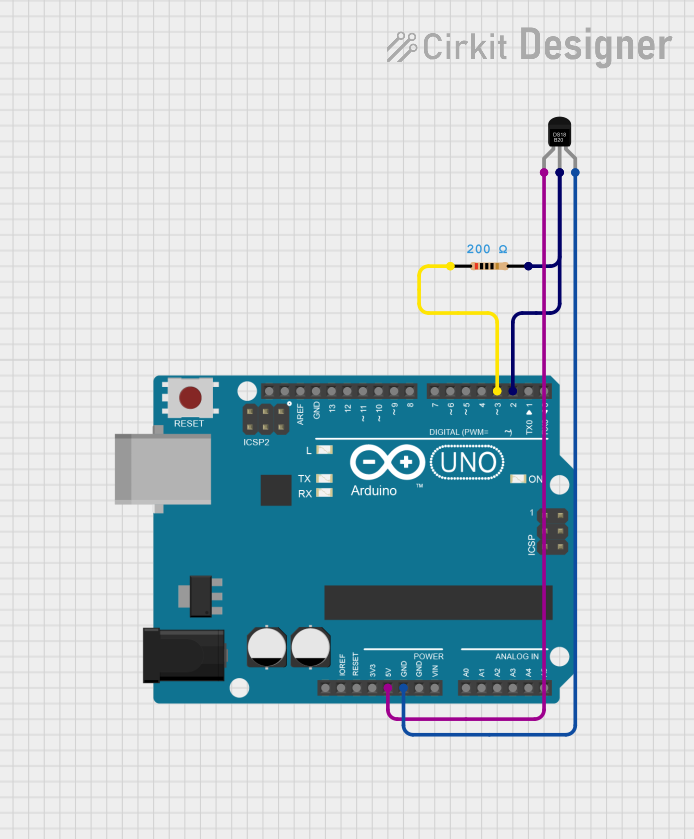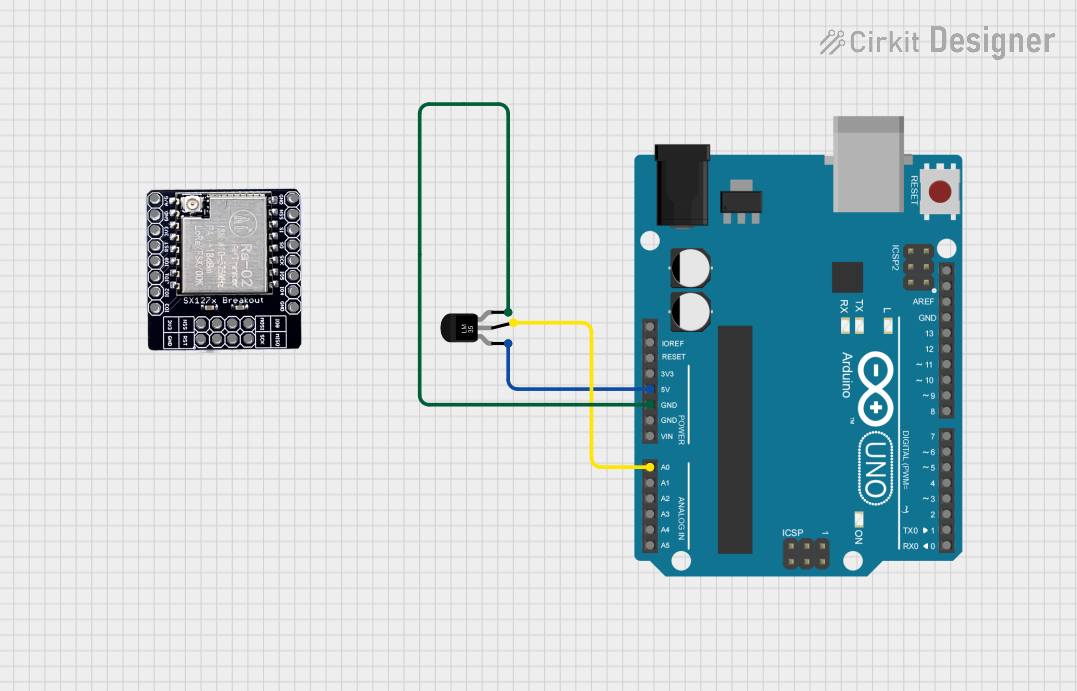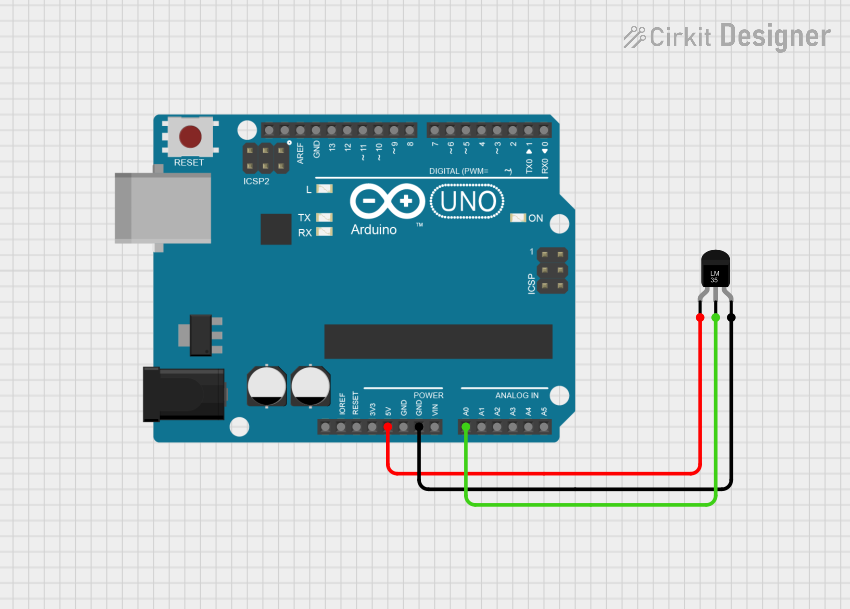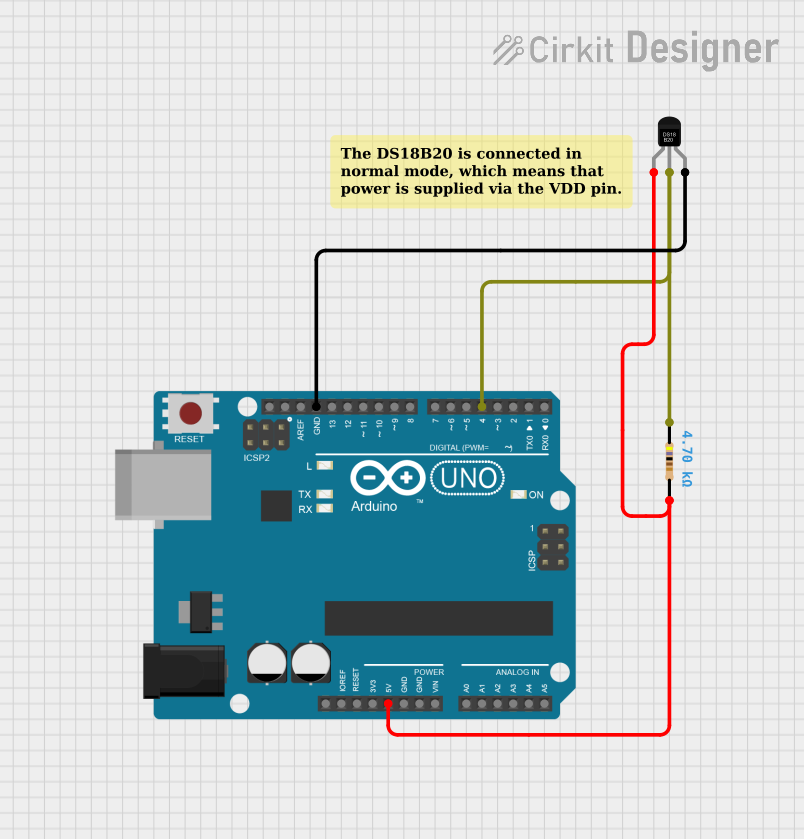
How to Use Temperature Sensor : Examples, Pinouts, and Specs

 Design with Temperature Sensor in Cirkit Designer
Design with Temperature Sensor in Cirkit DesignerIntroduction
A temperature sensor is a device that measures the temperature of its environment and converts the measurement into an electrical signal for monitoring or control purposes. These sensors are widely used in various applications, including HVAC systems, industrial automation, medical devices, and weather monitoring systems. They are essential for maintaining temperature-sensitive processes and ensuring safety in many systems.
Common types of temperature sensors include thermistors, thermocouples, and integrated circuit (IC) temperature sensors. Each type has its unique characteristics and is suited for specific applications.
Explore Projects Built with Temperature Sensor

 Open Project in Cirkit Designer
Open Project in Cirkit Designer
 Open Project in Cirkit Designer
Open Project in Cirkit Designer
 Open Project in Cirkit Designer
Open Project in Cirkit Designer
 Open Project in Cirkit Designer
Open Project in Cirkit DesignerExplore Projects Built with Temperature Sensor

 Open Project in Cirkit Designer
Open Project in Cirkit Designer
 Open Project in Cirkit Designer
Open Project in Cirkit Designer
 Open Project in Cirkit Designer
Open Project in Cirkit Designer
 Open Project in Cirkit Designer
Open Project in Cirkit DesignerTechnical Specifications
Below are the general technical specifications for a common IC-based temperature sensor, such as the LM35:
- Operating Voltage: 4V to 30V DC
- Output Voltage Range: 0V to 1.5V (for -55°C to 150°C)
- Temperature Range: -55°C to 150°C
- Accuracy: ±0.5°C (at 25°C)
- Output Sensitivity: 10mV/°C
- Current Consumption: 60 µA (typical)
- Response Time: <1 second
- Package Type: TO-92, SOIC, or DIP
Pin Configuration and Descriptions
The following table describes the pinout for a typical 3-pin temperature sensor like the LM35:
| Pin Number | Pin Name | Description |
|---|---|---|
| 1 | VCC | Power supply input (4V to 30V DC) |
| 2 | VOUT | Analog output voltage proportional to temperature |
| 3 | GND | Ground connection |
Usage Instructions
How to Use the Component in a Circuit
- Power Supply: Connect the VCC pin to a DC power source (4V to 30V) and the GND pin to the ground of the circuit.
- Output Signal: The VOUT pin provides an analog voltage proportional to the temperature. For example, at 25°C, the output voltage will be 250mV (10mV/°C).
- Signal Reading: Use an analog-to-digital converter (ADC) to read the output voltage if interfacing with a microcontroller.
Important Considerations and Best Practices
- Decoupling Capacitor: Place a 0.1 µF capacitor between VCC and GND to reduce noise.
- Avoid Overheating: Ensure the sensor is not exposed to temperatures beyond its specified range (-55°C to 150°C).
- Calibration: For critical applications, calibrate the sensor to improve accuracy.
- Placement: Position the sensor away from heat sources or airflow that could affect readings.
Example: Connecting to an Arduino UNO
Below is an example of how to connect and read data from a temperature sensor (e.g., LM35) using an Arduino UNO:
Circuit Connections
- Connect the VCC pin of the sensor to the 5V pin on the Arduino.
- Connect the GND pin of the sensor to the GND pin on the Arduino.
- Connect the VOUT pin of the sensor to the A0 analog input pin on the Arduino.
Arduino Code
// Define the analog pin connected to the temperature sensor
const int tempSensorPin = A0;
// Variable to store the sensor reading
int sensorValue = 0;
// Function to convert the analog reading to temperature in Celsius
float convertToCelsius(int analogValue) {
// LM35 outputs 10mV per degree Celsius
// Arduino ADC resolution is 5V/1024 = 4.88mV per step
float voltage = analogValue * (5.0 / 1024.0); // Convert ADC value to voltage
return voltage * 100.0; // Convert voltage to temperature in Celsius
}
void setup() {
Serial.begin(9600); // Initialize serial communication
}
void loop() {
sensorValue = analogRead(tempSensorPin); // Read the analog value
float temperature = convertToCelsius(sensorValue); // Convert to Celsius
Serial.print("Temperature: ");
Serial.print(temperature);
Serial.println(" °C"); // Print temperature to the serial monitor
delay(1000); // Wait 1 second before the next reading
}
Troubleshooting and FAQs
Common Issues
No Output Signal:
- Cause: Incorrect wiring or insufficient power supply.
- Solution: Double-check the connections and ensure the power supply voltage is within the specified range.
Inaccurate Readings:
- Cause: Electrical noise or poor placement of the sensor.
- Solution: Add a decoupling capacitor and place the sensor in a stable environment.
Fluctuating Output:
- Cause: Unstable power supply or interference.
- Solution: Use a regulated power supply and shield the sensor from external interference.
FAQs
Can I use the temperature sensor with a 3.3V system?
- Yes, but ensure the sensor's output voltage is within the ADC range of your microcontroller.
What is the maximum cable length for the sensor?
- The cable length depends on the environment and signal integrity. For long distances, use shielded cables or consider digital temperature sensors.
How do I measure negative temperatures?
- The LM35 outputs a voltage below 0V for negative temperatures. Use a dual power supply or a level shifter to read negative values.
By following this documentation, you can effectively integrate a temperature sensor into your projects and troubleshoot common issues.